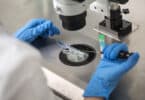In the United States, a single attempt at in-vitro fertilization (IVF) can cost families as much as $20,000. As many know, those attempts may or may not result in an actual baby, which means parents could spend hundreds of thousands of dollars to achieve a successful pregnancy. Overture Life, a startup robotics company, and a fertility clinic in New York City believe they may have found a more affordable solution.
It all started last spring, in Barcelona. Engineers created a sperm-injecting robot and then sent it by DHL to the New Hope Fertility Center. The entire system is comprised of a laptop, a mechanized needle, a microscope, a camera, and a small petri dish. An engineer with no experience in fertility medicine operated the device with a Playstation 5 controller.
“I was calm. In that exact moment, I thought, ‘It’s just one more experiment,’” says Eduard Alba, the student mechanical engineer who commanded the sperm-injecting device.
In total, they were able to fertilize more than a dozen eggs using this technology. Researchers say two healthy baby girls were born via the fertilizing robot. Some startups say this same process could be carried out automatically, without the aid of trained embryologists. Overture even believes the procedure could be carried out at a woman’s gynecologist’s office.
“Think of a box where sperm and eggs go in, and an embryo comes out five days later,” says Santiago Munné, the prize-winning geneticist who is chief innovation officer of the Spanish company. “It has to be cheaper. And if any doctor could do it, it would be.”
Entrepreneurs like David Sable, a former fertility doctor who now runs an investment fund, says the real goal is creating a lot more babies. Currently, about 500,000 children are born through IVF. If automated (and less expensive), more families could go through with the procedure.
“How do we go from half a million babies a year to 30 million?’” wonders David Sable, a former fertility doctor who now runs an investment fund. “You can’t if you run each lab like a bespoke, artisanal kitchen, and that is the challenge facing IVF. It’s been 40 years of outstanding science and really mediocre systems engineering.”
Full automation won’t be simple, however. Test tube conception involves a dozen different procedures, including freezing and nurturing the embryos. The Overture robot only performs one of the vital functions—sperm injection. An all-in-one machine does not yet exist.
“The concept is extraordinary, but this is a baby step,” says Gianpiero Palermo, a fertility doctor at Weill Cornell Medical Center. He is credited with developing the fertilization procedure known as intracytoplasmic sperm injection, or ICSI. Palermo also pointed out that Overture’s researchers still relied on manual assistance for tasks, such as loading the sperm cell into the injector needle. “This is not yet robotic ICSI, in my opinion.”
Some physicians are skeptical that robots can (or should) replace embryologists.
“You pick up a sperm, put it in an egg with minimal trauma, as delicately as possible,” says Zev Williams, director of Columbia University’s fertility clinic. He says, at least for now, “humans are far better than a machine.”
Australian-based embryologist Jeremy Thompson has spent his entire career trying to figure out how to improve the lives of embryos as they grow. Up to this point, those efforts have yielded unambiguous results. Quite simply, people aren’t yet ready to trust an embryo—a potential person—to a micro device. There’s just too much risk that the embryo could get trapped or harmed. He has made some steps forward, however, by developing “pods,” or “micro-cradles” that could minimize the stress that an embryo experiences during the growing process.
Another issue science is tackling is the selection of sperm; eggs must be matched with a healthy specimen if fertilization is going to take place. Humans can eye a few specimens at a time, but a computer could do the job far more efficiently, says Alejandro Chavez-Badiola, a fertility specialist in Mexico. His company, IVF 2.0 developed a software program that can analyze as many as 50 sperm in the time it would take a human to assess five or 10.
“We don’t claim it’s better than a human, but we do claim it’s just as good. And it never gets tired. A human has to be good at 8 a.m., after coffee, after having an argument on the phone,” he says.
Chief scientist at Innovation Fertility, Kathleen Miller, and her team are using computer systems to study time-lapse videos of growing embryos to try and determine why some grow into babies and others don’t. We’re putting it into models, and the question is “Tell me something I don’t know,” she says.“We’re going to see an evolution of what an embryologist is. Right now, they are technicians, but they’re going to be data scientists.”
Some scientists speculate that artificial wombs could be created, completely negating the need for implantation of the embryo. Gestation centers would then house the children until their “birth.” Others even claim that robots could eventually be shot into outer space to populate other planets, allowing us to create an entirely new society of humans.
“There are people thinking that humankind should be an interplanetary species, and human lifetimes are not going to be enough to reach out to these worlds,” says Chavez-Badiola. “Part of the job of a scientist is to keep dreaming.”
But most aren’t looking that far into the future. They just want to improve life here on Earth. For investment companies like Conceivable, it’s about making the technology more accessible, particularly in countries like the United States, where fewer than 2% of children are born through in-vitro. This is compared to roughly 10% of IVF babies in Denmark, where the procedure is both free and encouraged.
“That is the true demand,” says Alan Murray, an entrepreneur with a background in software and co-working spaces who co-founded Conceivable with his business partner, Joshua Abram. “The challenge is that these wonderful rich and eccentric countries can do it, but the rest of the world cannot. But they have demonstrated the true human need. What they have done with money, we need to do with technology.”
Genetic modifications may even become easier as technology progresses. Overture Life says they have no plans to make this a reality, but “it should be very easy to add to the machine,” says Munne.







